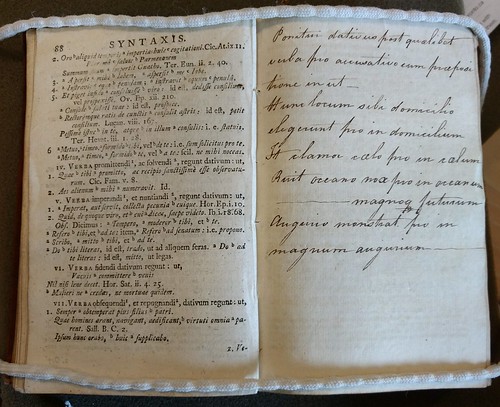A short introduction of grammar, generally to be used - 1784
By far the most recent book on display here, the 18th century A short introduction of grammar, generally to be used compiled and set forth for the bringing up of all those, that intend to attain to the knowledge of the Latin tongue. The volume has prefaces in both English and Latin and uses English as the language of apparatus for teaching Latin. The final section, Brevissima Institutio seu Ratio Grammatices, has its own title page and contains a further Latin grammar in Latin, perhaps for a more advanced student.
The CRRS copy bears signs of heavy use and has been rebound with blank sheets interleaved into several of the signatures, some containing extensive handwritten notes. The organization of the Short Introduction is largely the same as that of a student grammar produced today, and bears the physical signs of having been used, not as a scholarly literary reference for occasional consultation, but a living, used and abused textbook.
Organization:
Within the text, roman type is used for English and italic for Latin. However, in the tables the Latin word is set in roman (with an italic article) and the translation is in italics.
Bibliographic Information
Title
Date
Place
Publisher
Language
Contributor
Imprint
Condition
Leather bound, small book, cover stamped T. Pilkington twice, both stamps are missing letters.
Collation
Small Quarto: A-P8 ($4, – G1, -O2), 2 A-E8 ($4), 3A4 ($2), 3B-N8 ($4, -G3) O2 ($1)
In the first run of signatures, single sheet interpolations follow L6 and L7. Signatures M and N are interleaved with a full blank sheet (blank, M1, blank, M2, blank, M3, etc.) with single sheets interpolated at center (between 4 and 5), (N1, blank, etc., with blank single sheet at end). Sheets interleaved with M have notes on them.
In signature O, O1 is followed by a single sheet, O2-6 have sheets interleaved, and a single sheet between O4-5. In the third run, blank sheets follow D4, E1, E2, E3, E4, F1, F2, F4, F5, F7 , G1, G4, G6, G7 ( the sheet following 1 and 7 is single sheet), H1, K2, K3, K4, K5, (a single sheet folded between 3 and 5) 6, 7, 8 and L1. Many of these are half sheets stuck between, some are folded and wrap around the existing signatures.










